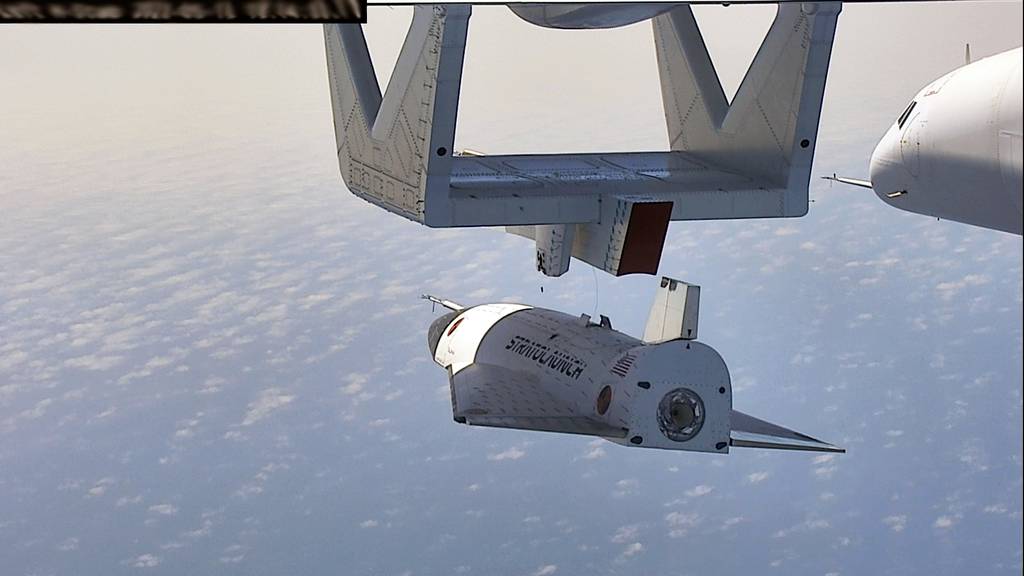Following a successful test flight in which its Talon-A vehicle reached near-hypersonic speeds, Stratolaunch is preparing for its next mission to reach or surpass the milestone of five times the speed of sound.
The March 9 test hit all of its primary objectives, according to Stratolaunch CEO Zachary Krevor. Taking off from Stratolaunch’s manufacturing and test facility at Mojave Air and Space Port in California, the uncrewed vehicle separated from its carrier craft and reached high supersonic speeds before dropping into the Pacific Ocean.
“This was really focused on risk reduction for our platform,” Krevor told C4ISRNET in a March 11 interview. “We got through acceleration, through the transonic phase into the supersonic phase — that was our primary objective.”
An aircraft achieves hypersonic speeds when it reaches Mach 5, and Krevor said the first powered Talon-A got close to that rate. The company would not disclose the altitude or exact speed of the test flight.
For Stratolaunch’s second powered Talon-A mission, scheduled for the second half of this year, it wants to push the uncrewed aircraft’s envelope further. The goal is to reach hypersonic speeds and to demonstrate reusability, landing the system on a runway.
The vehicle, dubbed TA-2, won’t undergo any structural changes before the flight, Krevor said, noting that the first mission validated the aircraft’s design and construction. The company is, however, considering operational lessons from the TA-1 vehicle.
“There’s certainly some operational lessons that we’ve learned regarding our propellant management and how can we continue to improve,” he said. “We are a company that believes strongly in continuous improvement.”
A successful Talon-A test campaign has significant implications for the Defense Department’s hypersonic efforts, which are focused on fielding the advanced weapons and defending against similar systems that China and Russia are building.
DoD is working to increase its testing rigor, setting a goal in 2022 to eventually conduct one flight each week. Talon-A could provide the department with a reusable, more affordable platform to test and validate high-speed components, subsystems and other technologies.
Talon-A’s first powered flight provided some data to U.S. Defense Department customers, including the Pentagon’s Test Resource Management Center, which is developing an airborne hypersonic test capability called SkyRange.
The next flight will take that partnership a step further, with SkyRange’s advanced sensors tracking the mission. It will also be the first flight to support the Pentagon’s Multi-Service Advanced Capability Hypersonics Test Bed program, or MACH-TB. The flying testbed effort is designed to validate hypersonic subsystems, advanced materials and other technologies.
The next mission is one of five Talon-A test flights that will carry MACH-TB payloads as part of a contract inked in November.
The company is also working to ensure its behemoth Talon-A carrier vehicle, dubbed Roc, is prepared for its next mission. The aircraft, which has a wingspan of 385 feet and can fly 500,000 pounds of payload, will perform a series of flights aimed at increasing its altitude for the next Talon-A mission.
The flights are part of mandatory Federal Aviation Administration inspections to validate Roc’s airworthiness.
Krevor noted that for the TA-1 mission, Roc’s 14th flight, the aircraft demonstrated a two-week turnaround time and brought its total flight time to around 60 hours.
“Roc really is turning into a dependable aircraft that’s going to be a national asset for the United States to perform missions that, frankly, were unable to be accomplished previously,” he said.
Stratolaunch is also preparing its second carrier aircraft — a Boeing 747 owned by Virgin Orbit before the company declared bankruptcy last spring — to support Talon A missions next year. The company is performing modifications on the platform to ensure it is compatible with its data systems and interfaces.
The aircraft will support some classified DoD testing before it starts flying Talon A missions.
“I can’t talk in great detail about it, but the 747 will support additional customer flight testing in the fourth quarter of this year,” Krevor said.
Courtney Albon is C4ISRNET’s space and emerging technology reporter. She has covered the U.S. military since 2012, with a focus on the Air Force and Space Force. She has reported on some of the Defense Department’s most significant acquisition, budget and policy challenges.








